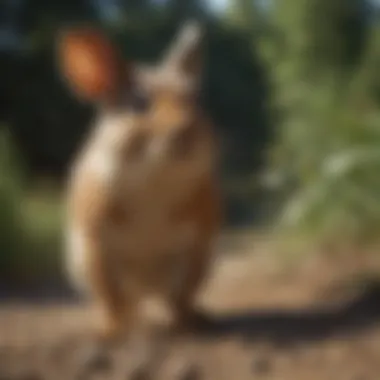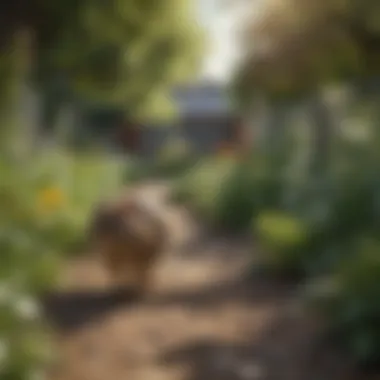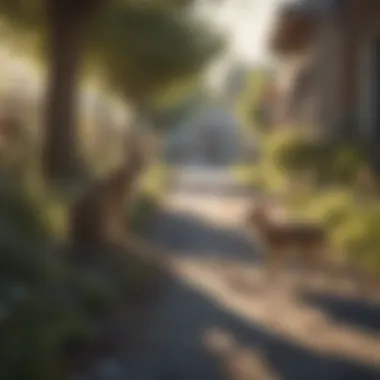Comprehensive Guide to Managing Suburban Wildlife Encounters
Preventive Pest Control Strategies
To effectively address suburban wildlife control, it is paramount to start with Preventive Pest Control Strategies. These strategies serve as the initial line of defense in safeguarding your property against unwanted wildlife intrusions. By meticulously implementing these preventive measures, you can significantly reduce the chances of encountering wildlife in your suburban area.
House Exterior Protection
When it comes to protecting your house exterior from potential wildlife invasions, paying attention to detail is key. Begin by inspecting your home for any cracks or gaps that could serve as entry points for pests. Sealing these openings with the appropriate materials is crucial in fortifying your property against unwelcome critters. Additionally, clearing debris such as fallen leaves and branches around your house perimeter can deter wildlife from nesting near your home. An often-overlooked aspect of house exterior protection is preventing pests from entering through windows and doors. Ensuring that screens are intact and sealing any gaps around windows and doors can go a long way in minimizing wildlife access.
Yard Maintenance
Maintaining a well-kept yard is essential in mitigating the risk of wildlife infestations. By following essential yard care routines such as mowing the lawn regularly, pruning shrubs and trees, and removing any standing water sources, you can create an environment that is less attractive to pests. Implementing methods for keeping your yard pest-free, such as natural repellents and pest-resistant plants, can further enhance your property's defenses against wildlife intrusions.
Indoor Cleanliness
Indoor cleanliness plays a significant role in preventing pests from taking up residence in your home. Expert cleaning tips and techniques, including vacuuming regularly, storing food in airtight containers, and sealing cracks in walls and floors, help create a pest-resistant indoor environment. Keeping clutter to a minimum and promptly addressing any spills or crumbs can also discourage wildlife from seeking shelter inside your home.
Garbage Disposal
Proper garbage disposal is a critical component of effective pest control. Implementing efficient waste disposal methods, such as securing trash bins with tight-fitting lids and disposing of garbage regularly, helps eliminate potential food sources for wildlife. Emphasizing the importance of proper garbage disposal to all household members can contribute to a cleaner and less pest-prone living space.
Other Pest Prevention Strategies
In addition to the aforementioned preventive measures, exploring innovative ways to safeguard your home against wildlife infestations can provide added protection. This may include installing motion-activated lights, utilizing sonic repellent devices, or implementing natural deterrents like vinegar or ammonia. By combining various pest prevention strategies, you can create a comprehensive defense system that minimizes the likelihood of wildlife encounters on your property.
Introduction
Suburban areas are increasingly facing challenges when it comes to wildlife encounters, necessitating a deep dive into effective strategies for suburban wildlife control. This comprehensive guide aims to equip housewives and homeowners with the knowledge needed to manage wildlife encounters effectively while safeguarding property and well-being. By understanding local wildlife dynamics and implementing humane deterrents, individuals can coexist peacefully with wildlife.
Understanding Suburban Wildlife Dynamics
Impact of Urbanization on Wildlife Behavior
Urbanization has significantly impacted wildlife behavior in suburban areas. The encroachment of human settlements into natural habitats has forced wildlife to adapt to these changing landscapes. This shift in behavior poses challenges for both humans and wildlife, leading to increased encounters and conflicts. Understanding how urbanization influences wildlife behavior is crucial to developing effective wildlife control strategies in suburban settings.
Common Wildlife Species in Suburban Areas


Suburban areas are home to a variety of wildlife species, each adapting to the human-dominated environment in unique ways. From squirrels and chipmunks to raccoons and opossums, these animals have found a niche in suburban ecosystems. Recognizing these common wildlife species is essential for implementing targeted control measures that are both effective and humane.
Ecological Importance of Wildlife in Suburban Ecosystems
Wildlife play a crucial role in maintaining the balance of suburban ecosystems. They contribute to pollination, seed dispersal, and pest control, among other essential functions. Understanding the ecological importance of wildlife in suburban areas sheds light on the interconnectedness of species and the impact of human activities on these delicate ecosystems.
Challenges of Wildlife Encounters in Suburbia
Property Damage Risks
Wildlife encounters in suburban areas pose significant risks of property damage. Animals seeking shelter or food can cause structural harm to buildings, destroy gardens, and create unsanitary conditions. Mitigating these risks requires proactive measures to secure properties and deter wildlife from causing damage.
Health and Safety Concerns
Wildlife encounters also raise concerns regarding the health and safety of inhabitants. Disease transmission, property damage, and the potential for physical harm are key issues associated with wildlife interactions in suburban settings. Addressing these health and safety concerns is paramount for ensuring the well-being of residents and the effective management of wildlife encounters.
Coexistence Challenges
Coexisting with wildlife in suburban areas presents unique challenges related to habitat sharing and resource competition. Balancing the needs of humans and wildlife requires thoughtful planning and collaboration within communities. Resolving coexistence challenges involves fostering understanding, implementing effective deterrent strategies, and promoting responsible wildlife management practices.
Identification and Assessment
In the world of suburban wildlife control, Identification and Assessment play a crucial role. By understanding the types of wildlife present in a particular area and evaluating their behaviors and habits, homeowners can better prepare themselves for potential encounters. This proactive approach aids in creating effective strategies for wildlife management, focusing on prevention and humane solutions. Identification and Assessment also enable homeowners to recognize potential vulnerabilities on their property, such as access points or attractants that may draw wildlife closer. By honing in on these key aspects, individuals can take targeted actions to mitigate risks and promote coexistence with local fauna.
Recognizing Common Urban Wildlife
Squirrels and Chipmunks
Squirrels and chipmunks are prevalent in suburban areas due to their adaptability and resourcefulness. Their quick movements and tree-dwelling nature make them common sights in residential neighborhoods. While their presence can be entertaining, these small rodents can also pose challenges by seeking shelter in attics or damaging gardens. Understanding their behaviors, such as nesting preferences and foraging patterns, is essential for effective wildlife control.
Raccoons and Opossums
Raccoons and opossums are known for their scavenging tendencies and nocturnal habits. These opportunistic omnivores can create messes while searching for food, tipping over trash cans or damaging outdoor structures. By identifying signs of their presence, such as tracks or droppings, homeowners can implement deterrent strategies to discourage these animals from frequenting their properties.
Birds and Bats


Birds and bats play vital roles in suburban ecosystems as active insect predators. While birds enrich the environment with their songs and vibrant plumage, bats contribute to pest control by consuming insects. However, their presence can also lead to conflicts when nesting in unwanted areas or roosting in attics. Recognizing the benefits and challenges of hosting these winged creatures can guide homeowners in fostering a balanced coexistence with urban wildlife.
Assessing Property Vulnerabilities
Entry Points and Nesting Sites
Identifying and securing potential entry points and nesting sites on a property is essential for preventing wildlife intrusions. Common vulnerabilities include gaps in siding, chimneys, or roof overhangs that may provide access to animals seeking shelter. By fortifying these areas with physical barriers or deterrents, homeowners can reduce the risk of wildlife establishing nests or dens within their homes.
Food and Water Sources
Assessing and managing food and water sources is critical for minimizing wildlife interactions in residential areas. Trash bins, bird feeders, and standing water can attract animals like raccoons or birds, leading to increased wildlife presence. By securing trash receptacles, restricting access to pet food, and eliminating standing water sources, homeowners can deter wildlife from foraging on their property.
Potential Attractants
Identifying and addressing potential attractants is key to creating an inhospitable environment for urban wildlife. Items such as fallen fruits, unsealed compost bins, or excessive vegetation can draw animals closer to human habitats. By removing attractants and implementing habitat modifications, homeowners can reduce the likelihood of wildlife conflicts and promote a harmonious coexistence with nature.
Implementing Effective Wildlife Control
In this comprehensive guide on addressing suburban wildlife control, focusing on the implementation of effective wildlife control strategies takes center stage. Understanding the dynamics between humans and wildlife in suburban areas is crucial for harmonious coexistence. Effective wildlife control not only safeguards property and well-being but also contributes to the conservation of local ecosystems. By implementing successful wildlife control measures, homeowners can mitigate conflicts and promote a safer and healthier environment for both humans and wildlife.
Humane Deterrent Strategies
Exclusion Techniques
Exclusion techniques form a fundamental aspect of humane deterrent strategies in addressing suburban wildlife encounters. These techniques involve identifying and sealing off potential entry points such as gaps in structures or vents that wildlife animals could utilize for access. The key characteristic of exclusion techniques lies in their proactive nature, focusing on preventing wildlife access rather than reactive measures. This approach not only deters wildlife from invading properties but also respects the animals' natural habitats by creating physical barriers. While exclusion techniques are effective in minimizing wildlife intrusions, homeowners should regularly inspect and maintain exclusion structures to ensure long-term success.
Natural Repellents
Natural repellents play a significant role in humane deterrent strategies by utilizing scents or tastes that wildlife find unappealing. These repellents often consist of natural ingredients like pepper, citronella, or vinegar that discourage wildlife from foraging or nesting on properties. The key characteristic of natural repellents is their eco-friendly composition, posing minimal risks to the environment, pets, and humans. While natural repellents offer a non-invasive approach to deterring wildlife, their effectiveness may vary based on the targeted species and environmental factors. Homeowners can experiment with different natural repellents to find the most suitable option for their specific wildlife control needs.
Behavior Modification
Behavior modification techniques focus on altering the behavior of nuisance wildlife through conditioning or redirection. By understanding the behavior patterns of common urban wildlife species, homeowners can implement strategies to discourage undesirable actions. The key characteristic of behavior modification is its sustainable impact, aiming to instill long-term changes in wildlife behavior. Homeowners can use methods like noise deterrents, motion-activated devices, or habitat modifications to deter wildlife from frequenting their properties. While behavior modification techniques require consistency and monitoring, they offer a humane approach to addressing wildlife conflicts without causing harm.
Professional Intervention Options


Wildlife Removal Services
Wildlife removal services provide homeowners with professional assistance in managing complex wildlife situations. These services often involve skilled technicians who safely capture and relocate wildlife animals to suitable habitats. The key characteristic of wildlife removal services is their expertise in handling diverse wildlife species, ensuring effective and humane solutions. While wildlife removal services offer immediate relief from wildlife intrusions, homeowners should consider the long-term implications of disrupting local ecosystems. Consulting with reputable wildlife removal services can help homeowners make informed decisions regarding the ethical and legal aspects of wildlife control.
Consulting with Experts
Consulting with wildlife control experts offers homeowners valuable insights into sustainable wildlife management practices. These experts possess in-depth knowledge of local wildlife species and their behaviors, allowing them to provide tailored recommendations for effective wildlife control. The key characteristic of consulting with experts is their customized approach, considering the unique challenges and opportunities presented by each property. While engaging with wildlife control experts may incur additional costs, the long-term benefits of implementing informed strategies can outweigh the initial investment. By collaborating with experts, homeowners can enhance their understanding of wildlife dynamics and implement proactive measures to prevent future conflicts.
Permitting and Legal Considerations
Navigating permitting and legal considerations is essential when undertaking wildlife control activities in suburban areas. Homeowners must adhere to relevant wildlife protection laws and regulations to ensure compliance and ethical practices. The key characteristic of permitting and legal considerations is their role in promoting responsible wildlife management and conservation. While obtaining permits and understanding legal obligations may require extra effort, it demonstrates a commitment to sustainable coexistence with wildlife. By familiarizing themselves with local wildlife protection laws, homeowners can approach wildlife control ethically and contribute to the preservation of biodiversity in suburban ecosystems.
Creating a Wildlife-Friendly Environment
In this section of the comprehensive guide on addressing suburban wildlife control, we delve into the crucial aspect of creating a wildlife-friendly environment. In the urban landscape, it is imperative to strike a balance between human habitation and wildlife conservation to ensure harmonious coexistence. By fostering a habitat that supports local wildlife while mitigating potential conflicts, homeowners can contribute to preserving biodiversity and enjoying the benefits of a thriving ecosystem.
Habitat Modification Practices
Landscaping for Wildlife Exclusion
Landscaping for wildlife exclusion plays a pivotal role in creating a wildlife-friendly environment by strategically designing outdoor spaces to deter unwanted wildlife from invading residential areas. The key characteristic of this practice lies in utilizing native plants that discourage wildlife intrusion while providing essential resources such as food and shelter. This approach not only enhances the aesthetic appeal of the landscape but also serves as a natural barrier against wildlife encroachment. However, the primary advantage of landscaping for wildlife exclusion is its ability to blend conservation efforts seamlessly into everyday landscaping practices without compromising the ecological integrity of the surroundings.
Securing Trash and Food Sources
Another critical aspect of promoting a wildlife-friendly environment is securing trash and food sources within suburban settings. By implementing secure waste management practices and minimizing access to food scraps, homeowners can effectively reduce the attraction of wildlife known for scavenging behaviors. The key characteristic of securing trash and food sources lies in employing durable containers and proper storage techniques that prevent wildlife access. While this approach may require initial adjustments in waste disposal habits, the long-term benefits include minimizing wildlife conflicts, promoting cleanliness, and safeguarding human and wildlife well-being.
Implementing Nature-friendly Features
Integrating nature-friendly features into residential landscapes further enhances the creation of a wildlife-friendly environment by incorporating elements that support local flora and fauna. This practice involves installing bird feeders, constructing wildlife shelters, and promoting biodiversity through pollinator-friendly plantings. The unique feature of implementing nature-friendly features is its ability to attract beneficial wildlife species, such as pollinators and insect-eating birds, which contribute to ecosystem balance and resilience. While the upkeep of these features requires commitment and attention to ecological design principles, the advantages include fostering a rich biodiversity, enhancing ecological connectivity, and creating immersive wildlife viewing opportunities within the comfort of one's home.
Community Engagement and Education
Neighborhood Initiatives
Engaging in neighborhood initiatives plays a crucial role in enhancing community understanding and involvement in creating a wildlife-friendly environment. By collaborating with neighbors to implement wildlife-friendly practices collectively, residents can foster a sense of shared responsibility towards wildlife conservation. The key characteristic of neighborhood initiatives is their ability to unite individuals with a common goal of promoting environmental stewardship and sustainable living practices within suburban neighborhoods. While this approach may require coordination and cooperation among residents, the advantages include building a sense of community, cultivating a culture of environmental awareness, and establishing long-term relationships based on shared conservation values.
Educational Outreach Programs
Educational outreach programs serve as valuable tools for disseminating knowledge and raising awareness about wildlife conservation and habitat protection. By participating in workshops, seminars, and informational sessions, community members can gain insights into the importance of creating wildlife-friendly environments and learn practical strategies for coexisting peacefully with local wildlife. The key characteristic of educational outreach programs is their capacity to empower individuals with the information needed to make informed decisions regarding wildlife interactions and habitat management. While the success of these programs depends on active participation and community engagement, the advantages include fostering a culture of learning, encouraging proactive conservation actions, and instilling a sense of responsibility towards environmental stewardship.
Wildlife Conservation Efforts
Supporting wildlife conservation efforts at the community level contributes significantly to the preservation of biodiversity and the protection of native species within suburban landscapes. By participating in conservation projects, habitat restoration initiatives, and wildlife monitoring programs, residents can actively engage in safeguarding local ecosystems and ensuring the continuity of essential ecological processes. The key characteristic of wildlife conservation efforts lies in their direct impact on enhancing habitat quality, promoting species diversity, and fostering ecological resilience in the face of urbanization pressures. While these efforts require commitment, resources, and collaboration with environmental organizations, the advantages include contributing to broader conservation goals, enhancing the ecological value of suburban areas, and leaving a lasting legacy of responsible environmental stewardship within the community.



